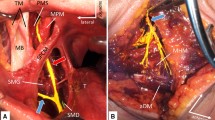Abstract
The styloglossus is one of the three extrinsic muscles of the tongue; it enters the tongue from behind. During human dissection practice for dental students at the Showa University School of Dentistry in 2006, the authors observed anomalous muscle arising from the inner surface of the mandibular angle and inserting into the tongue bilaterally. This muscle was termed myloglossus by Wood. On the right side, the myloglossus was accompanied by a weak rudimentary styloglossus, but the styloglossus was absent on the left side. The hypoglossal nerve innervated the myloglossus bilaterally, and a small branch of mandibular nerve also entered the muscle on the left side. The styloglossus develops from the styloid process and the mandibular angle as a bicipital muscle, but the segment attached to the mandibular angle generally atrophies during development. The present anomalous muscle was thought to represent persistence of this muscle bundle arising from the inner surface of the mandibular angle. The innervation of the innermost part of the left myloglossus by the mandibular nerve was explained by persistence of a vestigial nerve supplying a small muscle bundle originating from the tensor veli palatini, which had fused to the myloglossus.
Similar content being viewed by others
References
Barnwell YM (1977) The morphology of musculus styloglossus in fifteen-week human fetuses. Int J Oral Myol 3, 8–46.
Benoit R, Lemire M, Saban R (1985) Embryogenèse du styloglosse chez I’embryon humain. Ses rapports avec les structures viosines. J Biol Buccale 13, 113–31 (in French).
Bergman RA, Thompson SA, Afifi AK, Saadeh FA (1988) Compendium of Human Anatomic Variation. Urban & Schwarzenberg, Baltimore.
Cohen SR (1993) Soft-palate myogenesis: A developmental field paradigm. Cleft Palate-Craniofac J 30, 441–6.
Doménech-Ratto G (1977) Development and peripheral innervation of the palatal muscles. Acta Anat 97, 4–14.
Gruber W (1980) Ueber den musculeus myloglossus bei mangel und vorkommen des M. styloglossus. Arch Pathol Anat Physiol Klin Med 81, 453–7 (in German).
Hallett CH (1849) An account of the varieties of the muscular system met with in the dissecting room of the University of Edinburgh during the winter session 1847–48. Edinb Med Surg J 22, 1–20.
Hecht CS, Gannon PK, Eden AR (1993) Motor innervation of the Eustachian tube muscles in the guinea pig. Laryngoscope 103, 1218–26.
Koizumi M, Horiguchi M, Sekiya S, Isogai S, Makano M (1993) A case of the human sternocleidomastoid muscle additionally innervated by the hypoglossal nerve. Okajimas Folia Anat Jpn 69, 361–8.
Macalister A (1870) The varieties of the styloid muscles. J Anat Physiol 5, 28–31.
Macalister A (1875) Additional observations on muscular anomalies in human anatomy (third series) with a catalogue of the principal muscular variations hitherto published. Trans R Irish Acad 25, 1–130.
Mèrida-Viasco JR, Rodriguez-Vazquez JF, de la Cuadra Blanco C, Sánchez-Montesinos I, Mérida-Velasco JA (2006) Origin of the styloglossus muscle in the human fetus. J Anat 208, 649–53.
Moore KL (1985) Clinically Oriented Anatomy, 2nd edn. Williams & Wilkins, USA.
Shimada K, Gasser RF (1988) Morphology of the mandibulo-stylohyoid ligament in human adults. Anat Rec 222, 207–10.
Valenti G (1926) Sur un muscle mandibulo-glosse (M. myloglossus Wood). Arch Ital Biol 75, 77 (in Italian).
Williams PL, Bannester LH, Bery MM, Dyson M, Dussek JE, Ferguson MWJ (1995) Gray’s Anatomy, 38th edn. Churchill Livingstone, Edinburgh.
Wood J (1867) IV. Variations in human myology observed during the winter session of 1866–67 at King’s College. London Proc R Soc Lond 15, 518–46.
Zhang L, Yoshimura Y, Hatta T (2000) Reconstructing the pathway of the tensor veli palatini motor nerve during early mouse development. Anat Embryol 201, 235–44.
Author information
Authors and Affiliations
Corresponding author
Additional information
Correction added January 2008 after online publication: The article type has been corrected from Case Report to Original Article.
Rights and permissions
About this article
Cite this article
Nakajima, K., Nakamura, M. Rare case of myloglossus in Japanese cadaver: anatomical and developmental considerations. Anato Sci Int 83, 1–5 (2008). https://doi.org/10.1111/j.1447-073X.2007.00181.x
Received:
Accepted:
Issue Date:
DOI: https://doi.org/10.1111/j.1447-073X.2007.00181.x




